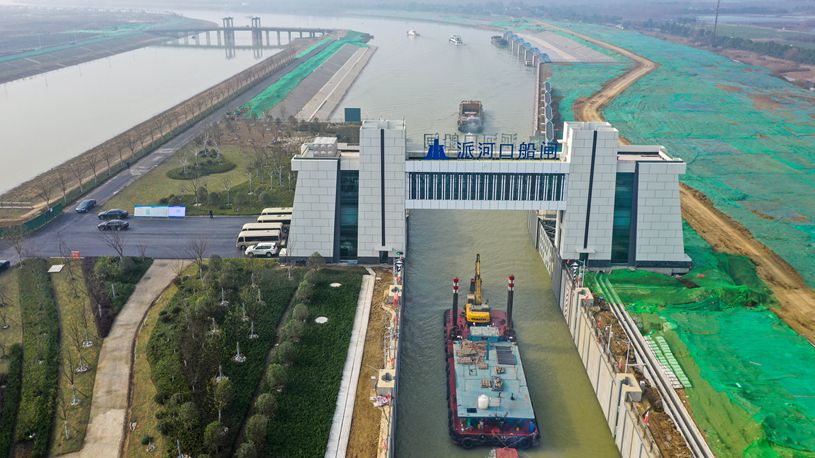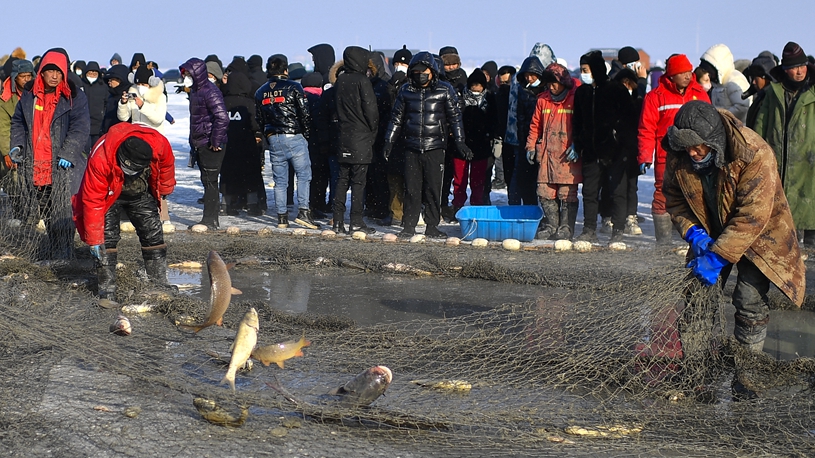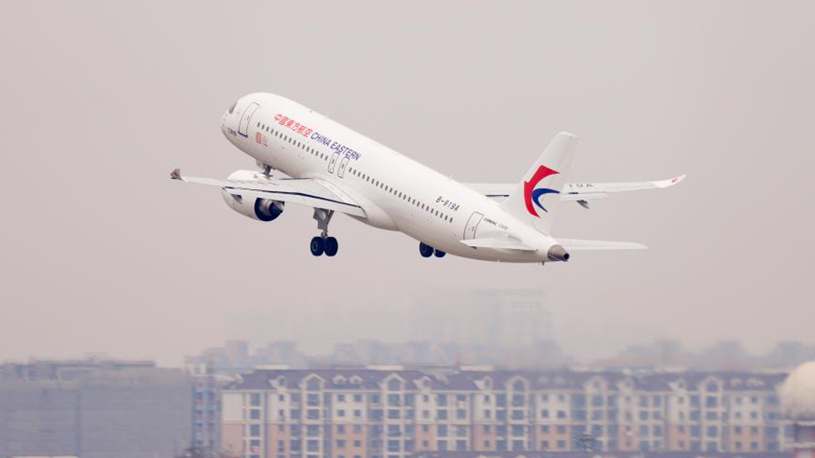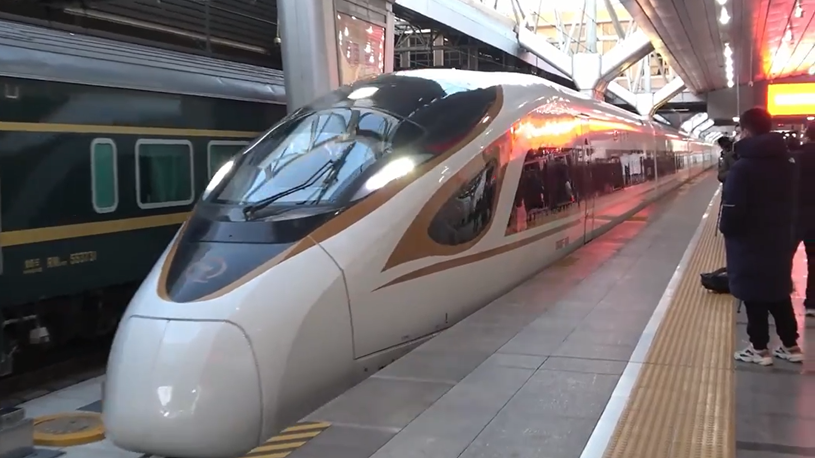* One year has passed since the RCEP entered into force. It is the world's largest free trade deal comprising 10 Association of Southeast Asian Nations (ASEAN) countries, as well as China, Japan, the Republic of Korea (ROK), Australia and New Zealand.
* As the world grapples with the COVID-19 pandemic and other uncertainties, the implementation of the trade pact offers a timely boost to the regional and global economy by stimulating trade between Asian-Pacific countries and deepening industrial chain integration in the region.
By Xinhua Writers Guo Yifan, Yao Yuan and Pan Qiang
BEIJING, Jan. 1 (Xinhua) -- In a factory in Shenzhen, a manufacturing hub in south China's Guangdong Province, machines run around the clock to turn colorful silk into elaborate outfits destined for Japan.
Thanks to reduced tariffs under the Regional Comprehensive Economic Partnership (RCEP), the Shenzhen China Silk Enterprise was able to gain a foothold in the Japanese market. New orders kept its factory busy, even as the COVID-19 pandemic continued to sap global demand.
In Shanghai, a financial center in east China, many locals had their first taste of Vietnamese coffee in a cafe opened by Vietnam-based Trung Nguyen Legend Group in September.
The cafe is the coffee company's first flagship branch outside of Vietnam. Its "Trung Nguyen G7" brand has also been launched on e-commerce platforms and in physical supermarkets in China, facilitated by lower tariffs and easier import procedures for Vietnam-grown coffee beans.
The RCEP, the world's largest free trade deal comprising 10 Association of Southeast Asian Nations (ASEAN) countries, as well as China, Japan, the Republic of Korea (ROK), Australia and New Zealand, entered into force on Jan. 1, 2022.
Over the past year, the agreement has lowered the cost of trade, facilitated the integration of industrial chains, and benefited consumers in the region. Its enforcement has helped the recovery of the Asia-Pacific economy, offsetting strong headwinds from sluggish global demand, the Russia-Ukraine conflict and aggressive U.S. interest rate hikes.
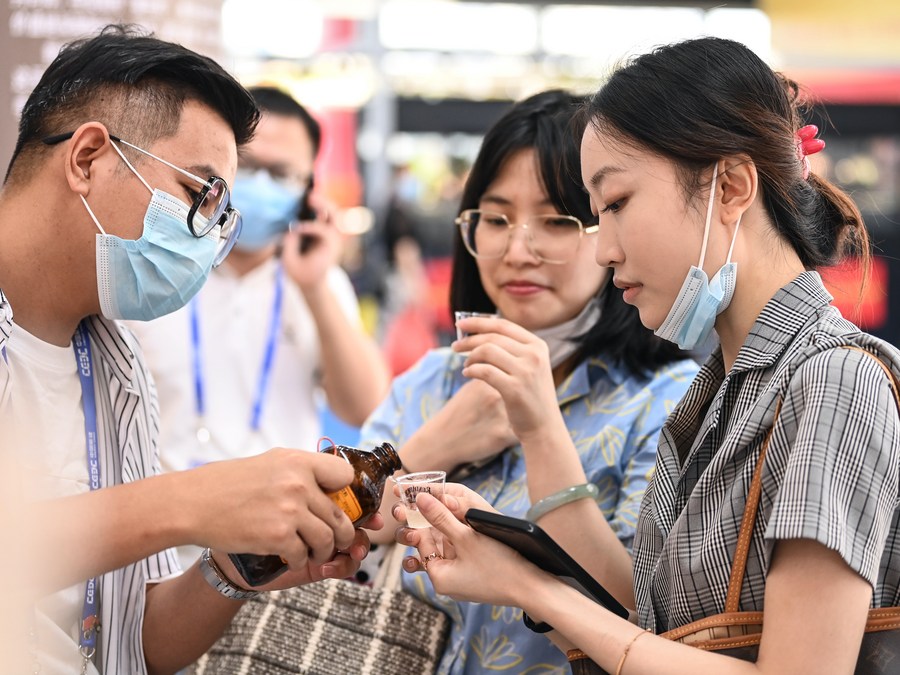
Visitors taste Japanese Sake at the Japan pavilion during the 19th China-ASEAN Expo in Nanning, south China's Guangxi Zhuang Autonomous Region, Sept. 18, 2022. (Xinhua/Zhang Ailin)
ROBUST TRADE
Data from the Ministry of Commerce (MOC) shows that China's trade with the other RCEP signatories expanded 7.9 percent year on year to 11.8 trillion yuan (about 1.69 trillion U.S. dollars) in the first 11 months of 2022, accounting for 30.7 percent of China's total foreign trade value.
Booming foreign trade has also been reported in some other member countries. Thailand's trade with RCEP member countries, which accounts for around 60 percent of its total foreign trade, rose 10.1 percent year on year to 252.73 billion U.S. dollars in the first nine months of 2022.
For Japan, the RCEP has brought the country and its largest trading partner China into the same free trade framework for the first time.
Japan's official data showed that the country's exports of agricultural, forestry, and fishery products and food hit 1.12 trillion yen (8.34 billion dollars) for the 10 months through October last year. Among them, exports to the Chinese mainland increased by 24.5 percent from the same time a year earlier, ranking first in export volume.
"Introducing zero tariffs when there is a large volume of trade will have the most significant effect on trade promotion," said Masahiro Morinaga, chief delegate of the Japan External Trade Organization's Chengdu office.
According to the RCEP, more than 90 percent of all merchandise traded in the region will eventually be subject to zero tariffs, an impetus for business celebrated by a growing number of companies.
Hao Zhiqiang, customs manager of Shandong Weihai Huanqiu Fishing Tackle Industrial Co., Ltd., has just printed an RCEP declaration of origin, so that their clients from the ROK can be exempted from paying 1,570 U.S. dollars in import duties for a batch of 500 fishing rods. Hao said the company issued over 100 such certificates in 2022.
"Despite the gloomy foreign trade situation under the COVID-19 pandemic, the RCEP and favorable policies have helped our company increase exports by about 10 percent year on year," Hao said.
Dealers in ASEAN countries have also lauded the easier access to the Chinese market enjoyed by an expanding list of agricultural products -- from Cambodian rice and Thai coconuts to Vietnamese passion fruit.
In early December, the Chinese cities of Chengdu and Chongqing welcomed direct trains loaded with durians, longans and other fruits from Thailand and Laos. Facilitated by the RCEP and an infrastructure boom, the Southeast Asian fruits can now reach southwest China faster and at lower prices.
Dinh Gia Nghia, deputy head of a food export company in Vietnam, estimated that in 2023, Vietnam's fruit and vegetable exports to China may increase considerably thanks mainly to smoother transport, quicker customs clearance and more efficient and transparent regulations and procedures under the RCEP arrangement, as well as e-commerce development.
"The RCEP has become a launching pad for us to increase product output and quality, as well as the quantity and the value of exports," said Nghia.
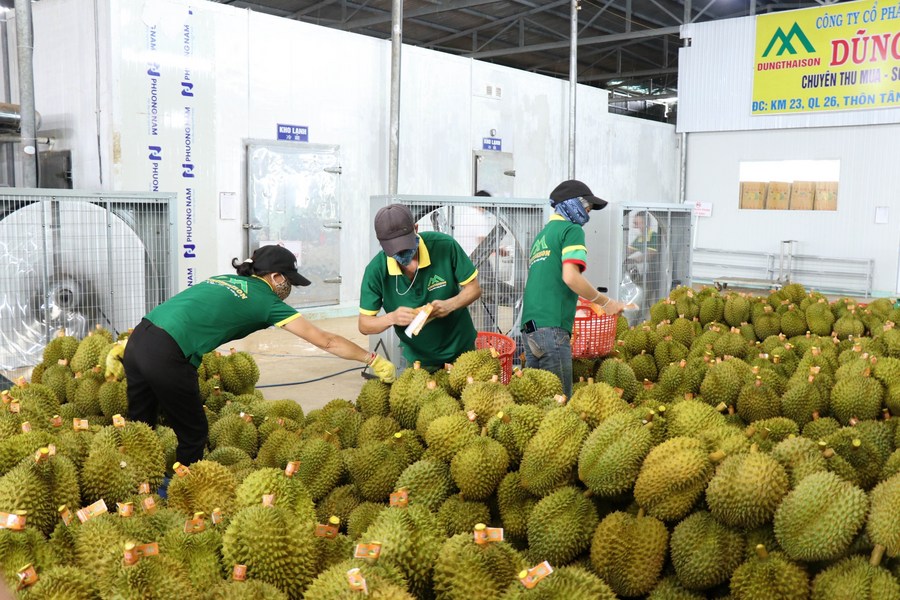
Staff members put stickers on fresh durians before exporting them to China at an export factory in Vietnam's Dak Lak province, on Sept. 17, 2022. (VNA/Handout via Xinhua)
OPTIMIZING INDUSTRIAL CHAIN
Business insiders say the RCEP's common rules of origin, which stipulate that product components from any member country would be treated equally, will increase sourcing options within the region and boost integration of the regional industrial and supply chains.
Guangxi Jingui Pulp & Paper Co., Ltd., owned by Indonesia's Asia Pulp & Paper Sinar Mas, said that raw materials such as wood pulp and starch imported from ASEAN countries have enjoyed preferential tariffs thanks to the RCEP. This has greatly reduced the company's production costs.
"We are about to start a new production line that will double the company's capacity to meet the increasing demand from both the Chinese and ASEAN markets," said Zhou Ju, the Guangxi company's logistics department director.
SAIC-GM-Wuling (SGMW), a Chinese automobile manufacturer, said the RCEP has reduced tariffs for auto parts, facilitating the company's production in Indonesia. SGMW's Wuling Air EVs rolled off the production line in Indonesia this year, and were used as shuttle cars for the G20 Summit in Bali.
"Tariffs on the export of completed new energy vehicles are relatively high, but by importing auto parts for local assembly (in Indonesia), we can enjoy the preferential rate of the RCEP," said Qin Zhenjie, G20 project manager of SGMW's Indonesian unit, adding that the company is expanding into the Southeast Asian market using this strategy.

Photo taken on March 2, 2022 shows a container terminal of Qinzhou Port in south China's Guangxi Zhuang Autonomous Region. (Xinhua)
Unified trade and investment rules under the RCEP will encourage enterprises in member countries to leverage the strengths of local industries, leading to the optimization of supply and industrial chains in the region, said Zhai Kun, deputy director of the Institute of Area Studies at Peking University.
More investment will also flow into the region as businesses want to benefit from the RCEP's tariff preferences, suggested Auramon Supthaweethum, director-general of the Department of Trade Negotiations under Thailand's Ministry of Commerce.
The RCEP has come "at the right time," as the pandemic weighs on the world economy and open trade remains important to post-pandemic recovery, she said, encouraging member countries to "benefit by working with China in the RCEP agreement." ■
(Zhou Qiang, Hao Huangming, Zhu Lili, Wang Feng, Ding Le, Sun Xiaohui, Yuan Min, Wang Yaguang, Tao Jun, Zhong Ya, Tu Yifan and Wu Xia have contributed to the story; Video reporters: Wang Qiwen, Liang Shun, Qin Guanghua, Huang Kaiying, Chen Luyuan, Chen Yifan, Wang Wei; Video editors: Zhang Yucheng, Zhu Jianhui, Wang Houyuan, Wu Yuzhan, Miao Zhuang)

